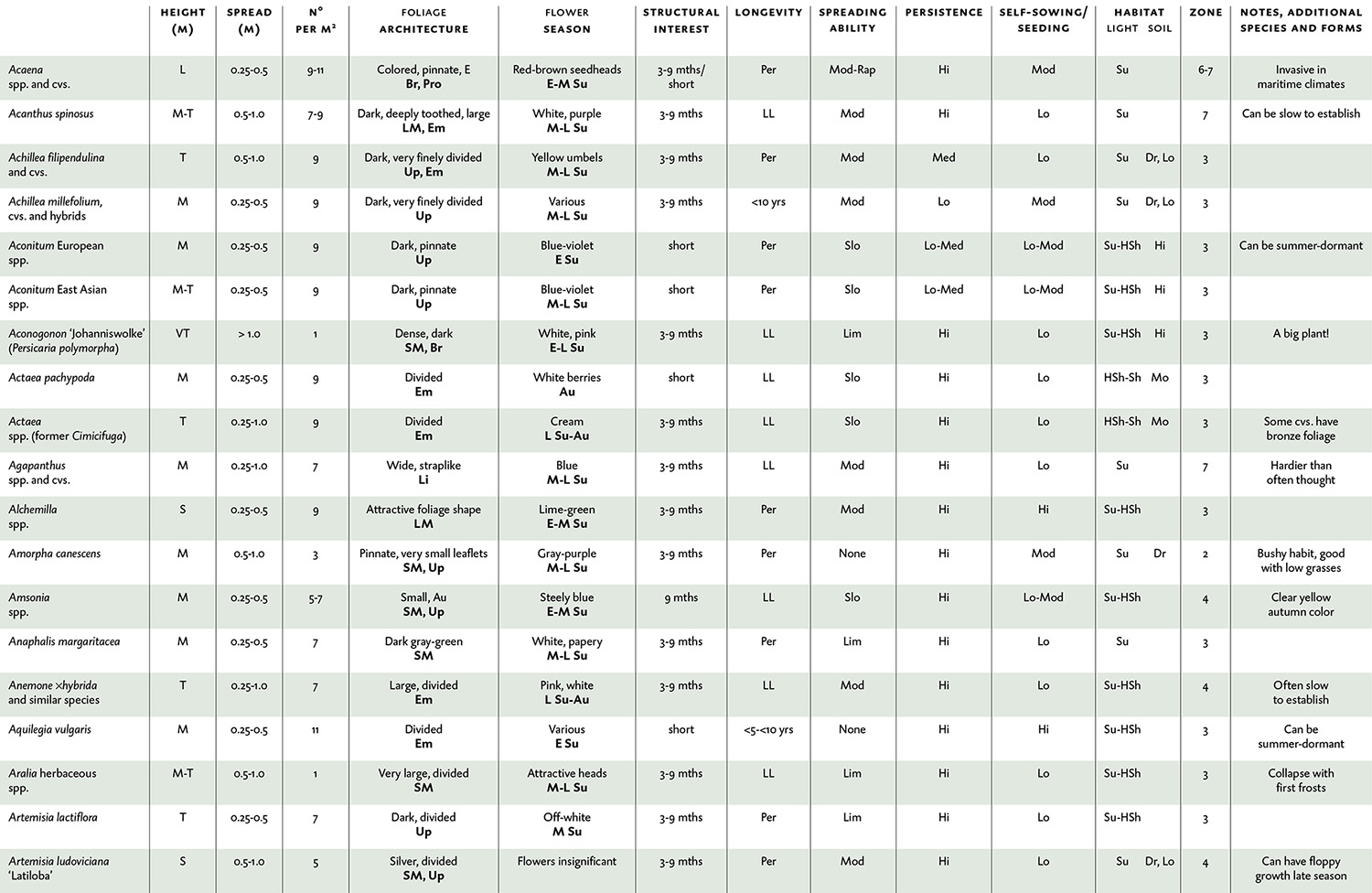
cvs. = cultivars
M = meters
Nº PER M2 = number per square meter
spp. = species (plural)
subsp. = subspecies
Plant height varies greatly between different growing conditions. These categories are intended to give a rough indication.
L |
Low, less than 0.3 meters |
S |
Short, 0.3–0.8 meters |
M |
Medium, 0.8–1.4 meters |
T |
Tall, 1.4–2.0 meters |
VT |
Very tall, greater than 2.0 meters |
The approximate diameter of the bulk of a plant’s foliage at its widest point after three years, NOT the spread of the base of the plant.
<0.25 |
Less than 0.25 meters |
0.25-0.5 |
Between 0.25 and 0.5 meters |
0.5-1.0 |
Between 0.5 and 1.0 meters |
>1.0 |
More than 1.0 meter |
This is a planting density suggested for commercial and other projects where a full look is wanted within the first year. It is not the same as spread, but takes into account the speed of establishment of a plant.
Piet Oudolf’s method is to use 9 centimeter pots for most perennials and 11 centimeter pots for larger ones like eupatorium or miscanthus. If only larger sizes (often 2 liters) are used, he recommends reducing planting density by 10–15 percent.
E |
Evergreen |
S/E |
Semi-evergreen |
Au |
Good autumn color |
This relates to the plant form as described by the stem-leaf relationships discussed in chapter three. In theory, this is an objective description; here, however, it has been modified to give a more subjective, and arguably more useful, assessment of the basic appearance of overall plant shape.
Li |
Linear leaves, virtually all basal |
BB |
Broad basal leaves |
Em |
Emergent |
LM |
Leafy mound |
Up |
Upright |
SM |
Stem mound |
Br |
Branching |
In addition: |
|
Pro |
Procumbent |
For grasses, with reference to page 127, the following descriptions are used: |
|
cespitose |
|
clump or mat |
|
Color is indicated.
Occasionally also a period of attractive berries is indicated. The flowering season for grasses also includes the period of seedhead interest.
Sp |
Spring |
Su |
Summer |
Au |
Autumn |
Wi |
Winter |
E |
Early |
M |
Mid |
L |
Late |
See page 132.
9 mths |
More than 9 months, implies good seedheads |
3-9 mths |
3 to 9 months, flowers and seedheads |
short |
Filler plants or only a short season of structural interest |
Data for performance are based on author experience, and that of colleagues, overwhelmingly in north-west Europe, and also reflect the research survey Kingsbury 2010 (see Further Reading).
Longevity. See pages 178–83.
<5 yrs |
Less than 5 years |
<10 yrs |
Less than 10 years |
Per |
True perennial |
LL |
Notably long-lived |
Spreading ability through vegetative growth, not seeding, and distinct from foliage spread – see ‘Spread’ on previous page. See pages 186–87.
None |
Non-clonal, not spreading |
Lim |
Very limited |
Slo |
Slow |
Mod |
Moderate |
Rap |
Rapid |
Persistence: lower numbers indicate plants die back in center and new growth is further away from original planting position. See pages 188–91.
V lo |
Very low |
Lo |
Low |
Med |
Medium |
Hi |
High |
Self-sowing/seeding. See pages 191–92. Note this is notoriously difficult to predict and this is a rough guide only.
Lo |
Low, often minimal |
Mod |
Moderate |
Hi |
High, occasionally problematic |
LIGHT: |
|
Su |
Sun |
HSh |
Half-shade |
Sh |
Shade-tolerant |
SOIL: |
|
All plants will flourish in average soil conditions, with average levels of fertility and moisture. |
|
We |
Some tolerance of wet – in other words, waterlogged soil |
Mo |
Moist (but not wet) soil preferred, drought not tolerated well |
Dr |
Drought tolerant, but growth is usually better in conditions of average moisture |
Hi |
Appreciates highly fertile soils |
Lo |
Tolerant of poor fertility, but growth is usually better in conditions of average fertility, although lifespan may be shorter |
United States Department of Agriculture Hardiness Zones, minimum recommended.
This is a good guide to winter hardiness for Continental climates, less so for maritime-influenced climates like north-west Europe. Zones describe geographical regions where winter minimum temperatures are the chief limiting factor for the cultivation of particular plant species. For example, a zone 5 plant will potentially tolerate temperatures down to minus 28°C or minus 20°F.

1. Acanthus spinosus
2. Amorpha canescens
3. Amsonia orientalis
4. Anaphalis margaritacea
5. Artimisia ludoviciana

1. Aruncus ‘Horatio’
2. Aster cordifolius ‘Little Carlow’
3. Aster lateriflorus ‘Horizontalis’
4. Aster tartaricus ‘Jindai’
5. Aster ×herveyi ‘Twilight’

1. Baptisia alba (B. leucantha)
2. Brunnera macrophylla
3. Chaerophyllum hirsutum ‘Roseum’
4. Clematis heracleifolia
5. Clematis integrifolia

1. Coreopsis tripteris
2. Crambe cordifolia
3. Echinacea ‘Fatal Attraction’
4. Echinops ritro
5. Eryngium yuccifolium

1. Euphorbia griffithii
2. Euphorbia schillingii
3. Filipendula rubra ‘Venusta’
4. Geranium phaeum
5. Geranium sylvaticum

1. Gillenia trifoliata
2. Helenium ‘Rubinzwerg’
3. Iris fulva
4. Kirengeshoma palmata
5. Knautia macedonica

1. Lathyrus vernus
2. Lavatera cachemiriana
3. Lunaria rediviva
4. Lysimachia ephemerum
5. Macleaya spp.

1. Nepeta subsessilis
2. Persicaria amplexicaulis
3. Persicaria bistorta
4. Phlox paniculata
5. Polygonatum ×hybridum

1. Pycnanthemum muticum
2. Rodgersia aesculifolia cultivar
3. Rudbeckia subtomentosa
4. Ruellia humilis
5. Selinum wallichianum

1. Solidago rugosa
2. Stachys byzantina ‘Big Ears’
3. Thalictrum aquilegifolium
4. Thalictrum rochebrunnianum
5. Tiarella wherryi

1. Veratrum nigrum
2. Verbesina alternifolia
3. Veronicastrum virginicum
4. Briza media
5. Calamagrostis acutiflora ‘Karl Foerster’

1. Eragrostis spectabilis
2. Eragrostis curvula
3. Festuca mairei
4. Hakonechloa macra
5. Pennisetum viridescens

1. Spodiopogon sibiricus
2. Stipa gigantea
3. Adiantum pedatum
4. Polystichum setiferum ‘Herrenhausen’